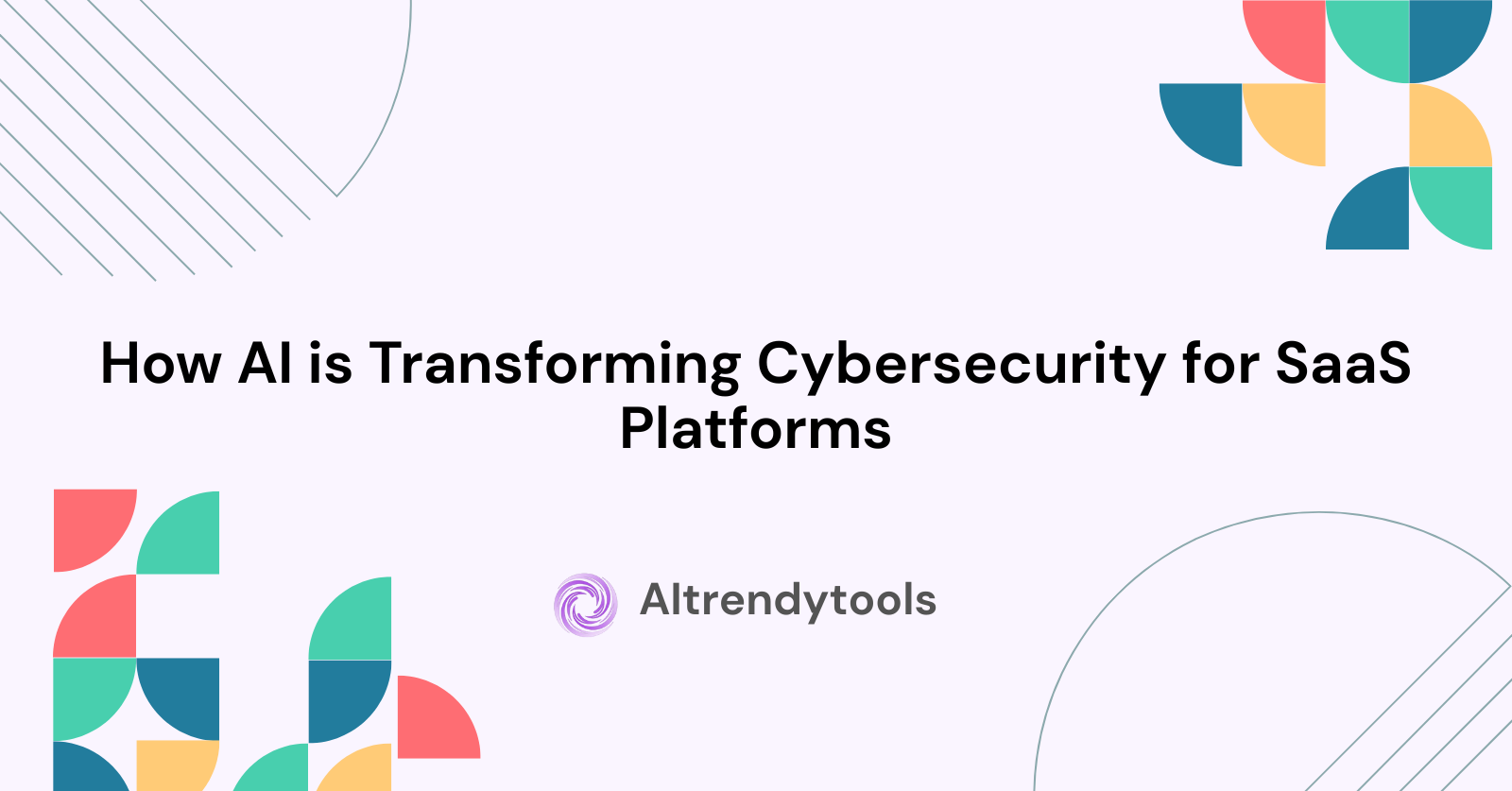🔥 AITrendytools: The Fastest-Growing AI Platform |
Write for usHow AI is Transforming Cybersecurity for SaaS Platforms
Discover how AI is transforming cybersecurity for SaaS platforms with real-time threat detection, predictive analytics, and automated incident response.
Sep 11, 2025
The digital landscape faces unprecedented challenges as cyber threats grow more sophisticated each day. SaaS platforms, hosting sensitive business data and critical applications, have become prime targets for cybercriminals. Traditional security measures struggle to keep pace with evolving attack vectors.
Artificial Intelligence emerges as a game-changing solution. AI-powered cybersecurity systems analyze vast datasets at lightning speed, detecting threats that human analysts might miss. These intelligent systems learn from each attack, becoming stronger and more effective over time.
Modern organizations rely heavily on cloud-based SaaS applications for daily operations. This dependency creates new vulnerabilities and expanded attack surfaces. AI cybersecurity addresses these challenges through automated detection, predictive analytics, and real-time response capabilities.
Understanding AI-Powered Threat Detection
Traditional cybersecurity relies on predefined rules and known threat signatures. This approach fails against zero-day attacks and sophisticated malware designed to evade detection. AI transforms this paradigm through advanced machine learning algorithms.
Machine learning models analyze network traffic patterns, user behaviors, and system activities. These models establish baseline behaviors for normal operations. When activities deviate from established patterns, the system flags potential threats for investigation.
Behavioral analysis represents a cornerstone of AI threat detection. Users typically follow predictable patterns when accessing applications and data. AI systems monitor these behaviors continuously, identifying anomalies that could indicate compromised accounts or insider threats.
The speed of AI analysis surpasses human capabilities by orders of magnitude. While security analysts might review hundreds of alerts daily, AI systems process millions of data points simultaneously. This processing power enables real-time threat detection and response.
Advanced Endpoint Protection Through AI
Endpoint devices serve as primary entry points for cyber attacks. Laptops, mobile devices, and IoT sensors create numerous vulnerabilities that traditional antivirus software cannot adequately protect. AI-powered endpoint protection platforms revolutionize device security.
Next-generation antivirus solutions leverage machine learning to identify previously unknown malware. These systems analyze file behaviors, execution patterns, and system modifications to detect malicious activities. Unlike signature-based detection, AI approaches catch zero-day exploits and fileless attacks.
Memory-based attacks present particular challenges for traditional security tools. AI systems monitor process execution in real-time, identifying suspicious activities like code injection or privilege escalation. This continuous monitoring prevents attacks that operate entirely in system memory.
Automated response capabilities distinguish AI endpoint protection from legacy solutions. When threats are detected, AI systems can automatically isolate infected devices, terminate malicious processes, and initiate remediation procedures. This immediate response prevents lateral movement and limits attack impact.
Device learning enhances protection over time. AI systems study attack patterns specific to organizational environments, customizing defenses based on actual threat experiences. This adaptive approach provides superior protection compared to one-size-fits-all security solutions.
Intelligent Network Traffic Analysis
Network monitoring traditionally relied on predefined rules and signature-based detection. AI transforms network security through deep packet inspection and traffic pattern analysis. Machine learning models identify suspicious communications that might indicate data exfiltration or command-and-control activities.
Anomaly detection algorithms analyze network flows continuously. These systems establish baselines for normal traffic patterns, including data volumes, communication protocols, and connection frequencies. Deviations from normal patterns trigger security alerts for investigation.
AI systems excel at identifying advanced persistent threats that use legitimate protocols for malicious purposes. These attacks often go undetected by traditional security tools because they mimic normal network activities. Machine learning models detect subtle indicators that reveal malicious intent.
Real-time analysis capabilities enable immediate threat response. Traditional network monitoring might take hours or days to identify sophisticated attacks. AI systems detect threats within minutes, enabling rapid containment and mitigation efforts.
The integration of multiple data sources enhances detection accuracy. AI platforms correlate network traffic data with endpoint telemetry, user activities, and threat intelligence feeds. This comprehensive approach reduces false positives while improving threat detection rates.
Predictive Analytics for Proactive Security
Predictive analytics represents one of AI's most powerful contributions to cybersecurity. Instead of merely reacting to attacks, AI systems anticipate threats before they materialize. This proactive approach transforms organizational security postures.
Threat intelligence feeds provide AI systems with global attack data. Machine learning algorithms analyze this information to identify emerging attack patterns and predict likely targets. Organizations can strengthen defenses against anticipated threats before attacks occur.
Risk assessment models evaluate organizational vulnerabilities continuously. These models consider factors like software versions, configuration settings, and user behaviors to calculate risk scores. High-risk areas receive additional security attention and monitoring.
Seasonal attack patterns become predictable through AI analysis. Cybercriminals often time attacks to coincide with holidays, financial quarters, or major events. AI systems recognize these patterns and adjust security measures accordingly.
The combination of internal and external data sources improves prediction accuracy. AI platforms analyze organizational data alongside global threat intelligence to create comprehensive risk profiles. This analysis helps prioritize security investments and resource allocation.
Automated Incident Response and Remediation
Traditional incident response processes require extensive human intervention and can take hours to initiate. AI-powered systems automate initial response procedures, dramatically reducing mean time to containment. This automation proves crucial when dealing with fast-moving threats like ransomware.
Playbook automation enables consistent response procedures across different threat types. AI systems execute predefined response workflows based on threat classifications. These automated responses include network segmentation, account disabling, and evidence collection.
Forensic analysis benefits significantly from AI assistance. Machine learning algorithms can rapidly analyze system logs, network traffic, and file modifications to reconstruct attack timelines. This analysis provides security teams with detailed information needed for thorough investigations.
Threat hunting capabilities extend beyond reactive security measures. AI systems proactively search for indicators of compromise within organizational environments. These hunting activities often uncover threats that evaded initial detection mechanisms.
Recovery procedures can be partially automated through AI orchestration. Systems can restore clean backups, rebuild compromised systems, and verify security configurations without extensive manual intervention. This automation accelerates recovery times and ensures consistent restoration procedures.
For organizations seeking cutting-edge AI tools to enhance their cybersecurity posture, platforms like AI Trendy Tools provide comprehensive directories of the latest AI-powered security solutions available in the market.
Identity and Access Management Revolution
User identity represents the new security perimeter in cloud-centric environments. Traditional perimeter-based security models prove inadequate when users access SaaS applications from various devices and locations. AI transforms identity and access management through continuous authentication and risk-based access controls.
Behavioral biometrics analyze how users interact with systems. AI models study typing patterns, mouse movements, and application usage habits to create unique behavioral profiles. These profiles enable continuous user authentication without disrupting user experiences.
Risk-based access control adjusts security requirements based on contextual factors. AI systems evaluate user locations, device types, network connections, and requested resources to calculate access risk scores. High-risk scenarios trigger additional authentication requirements or access restrictions.
Privilege escalation detection identifies users attempting to access resources beyond their normal scope. AI systems monitor access patterns and flag unusual requests for sensitive data or administrative functions. This monitoring helps prevent both external attacks and insider threats.
Account takeover detection analyzes login patterns and post-authentication behaviors. Machine learning models recognize when legitimate user accounts exhibit unusual activities that might indicate compromise. Early detection prevents attackers from establishing persistent access.
SaaS-Specific Security Challenges
SaaS platforms present unique security challenges that traditional security tools struggle to address. Multiple applications, diverse APIs, and shared responsibility models create complex security environments. AI provides specialized solutions for these cloud-specific challenges.
Shadow IT discovery represents a critical capability for SaaS security. AI systems analyze network traffic and user activities to identify unauthorized cloud applications. This discovery enables organizations to manage and secure their complete application portfolios.
Data loss prevention in SaaS environments requires understanding of application-specific risks. AI systems analyze data flows between applications, identifying potential exfiltration attempts or inappropriate data sharing. This analysis provides granular protection for sensitive information.
API security monitoring detects attacks targeting application programming interfaces. AI systems analyze API call patterns, payload contents, and response behaviors to identify malicious activities. This monitoring protects against injection attacks, data scraping, and authentication bypass attempts.
Configuration drift detection identifies changes to SaaS application settings that might introduce vulnerabilities. AI systems monitor configuration baselines and alert administrators to potentially risky modifications. This monitoring ensures consistent security postures across application portfolios.
Machine Learning in Malware Detection
Malware evolution presents ongoing challenges for cybersecurity professionals. Traditional signature-based detection fails against polymorphic malware and zero-day threats. Machine learning provides adaptive detection capabilities that evolve alongside threat landscapes.
Static analysis examines file characteristics without executing potentially malicious code. AI models analyze file structures, metadata, and embedded resources to identify suspicious attributes. This analysis provides rapid threat assessment without execution risks.
Dynamic analysis observes malware behaviors in controlled environments. AI systems analyze execution patterns, system modifications, and network communications to understand threat capabilities. This behavioral analysis provides detailed threat intelligence for defense purposes.
Hybrid detection approaches combine multiple analysis techniques for comprehensive coverage. AI platforms integrate static analysis, dynamic analysis, and behavioral monitoring to maximize detection rates while minimizing false positives.
Adversarial machine learning addresses attempts to evade AI-based detection systems. Attackers increasingly use AI techniques to create evasion methods. Defensive AI systems must evolve to counter these sophisticated evasion attempts.
Real-Time Monitoring and Response
Real-time capabilities distinguish AI cybersecurity from traditional security tools. The ability to detect, analyze, and respond to threats within seconds proves crucial for preventing successful attacks. AI enables this real-time security through advanced processing and automation capabilities.
Stream processing analyzes security events as they occur rather than in batch operations. This continuous analysis enables immediate threat detection without waiting for scheduled security scans. Real-time processing proves essential for stopping fast-moving attacks.
Alert prioritization helps security teams focus on the most critical threats. AI systems analyze alert contexts, threat severities, and potential impacts to prioritize response efforts. This prioritization prevents alert fatigue and ensures critical threats receive immediate attention.
Automated containment procedures execute within seconds of threat detection. AI systems can isolate affected systems, block malicious communications, and initiate backup procedures without human intervention. This rapid response prevents attack spread and minimizes damage.
Continuous learning improves system performance over time. AI platforms analyze response outcomes and adjust detection algorithms based on effectiveness. This learning ensures security systems become more accurate and efficient through operational experience.
Future Trends and Emerging Technologies
The intersection of AI and cybersecurity continues evolving rapidly. Emerging technologies promise even more sophisticated security capabilities. Understanding these trends helps organizations prepare for future security challenges and opportunities.
Quantum computing presents both opportunities and challenges for cybersecurity. While quantum algorithms could break current encryption methods, quantum-enhanced AI might provide unprecedented threat detection capabilities. Organizations must prepare for this technological transition.
Edge computing requires distributed security approaches. AI-powered security systems must operate effectively in edge environments with limited resources and intermittent connectivity. This requirement drives development of lightweight AI security solutions.
Extended Detection and Response (XDR) platforms integrate multiple security tools through AI orchestration. These platforms provide comprehensive visibility across organizational environments while maintaining centralized management. XDR represents the evolution toward unified security operations.
Zero Trust architecture assumes no implicit trust within organizational networks. AI supports Zero Trust implementation through continuous verification, risk assessment, and adaptive access controls. This approach provides comprehensive security for modern distributed environments.
Advanced AI techniques like federated learning enable collaborative threat detection while preserving data privacy. Organizations can benefit from collective intelligence without sharing sensitive information. This approach accelerates threat detection improvement across entire industries.
Implementation Best Practices
Successful AI cybersecurity implementation requires careful planning and execution. Organizations must consider technical requirements, resource allocation, and change management aspects. These best practices guide effective AI security deployment.
Assessment and planning establish foundation requirements for AI security initiatives. Organizations should evaluate current security postures, identify priority use cases, and establish success metrics. This planning ensures AI investments address actual security needs.
Pilot programs allow organizations to test AI capabilities in controlled environments. Starting with limited scope implementations reduces risks while providing valuable learning experiences. Successful pilots provide templates for broader deployment initiatives.
Integration considerations ensure AI security tools work effectively with existing infrastructure. Organizations must evaluate compatibility requirements, data sharing capabilities, and operational workflows. Proper integration maximizes AI system effectiveness while minimizing operational disruption.
Training and skill development prepare security teams for AI-enhanced operations. Personnel must understand AI capabilities, limitations, and operational procedures. Comprehensive training ensures organizations realize full benefits from AI security investments.
Performance monitoring establishes metrics for evaluating AI system effectiveness. Organizations should track detection rates, false positive rates, and response times to assess system performance. Regular monitoring enables continuous optimization and improvement.
Organizations looking to explore the latest AI-powered cybersecurity tools can find comprehensive listings and reviews at AI Trendy Tools, which features cutting-edge solutions for modern security challenges.
Overcoming Implementation Challenges
AI cybersecurity implementation presents various challenges that organizations must address for successful deployment. Understanding these challenges and developing mitigation strategies ensures effective AI security initiatives.
Data quality requirements significantly impact AI system effectiveness. Machine learning models require high-quality training data to function properly. Organizations must invest in data collection, cleaning, and preparation processes to support AI security initiatives.
Integration complexity increases with organizational size and system diversity. Legacy systems may lack APIs or data export capabilities needed for AI integration. Organizations must plan integration approaches that accommodate existing infrastructure limitations.
False positive management remains crucial for operational effectiveness. Even advanced AI systems generate false alerts that can overwhelm security teams. Proper tuning and feedback mechanisms help reduce false positive rates over time.
Skills gaps affect many organizations implementing AI security solutions. Cybersecurity professionals need training in AI concepts and operational procedures. Organizations must invest in personnel development to realize AI security benefits.
Cost considerations include both initial implementation and ongoing operational expenses. AI security systems require significant computing resources and specialized expertise. Organizations must budget appropriately for comprehensive AI security initiatives.
Measuring Success and ROI
Demonstrating value from AI cybersecurity investments requires comprehensive metrics and analysis. Organizations must establish measurement frameworks that capture both quantitative and qualitative benefits. These frameworks guide ongoing optimization efforts and justify continued investments.
Detection improvement metrics measure AI system effectiveness compared to traditional security tools. Organizations should track threat detection rates, mean time to detection, and attack prevention success rates. These metrics demonstrate AI security value in concrete terms.
Operational efficiency gains result from AI automation and optimization. Organizations can measure reduced manual investigation time, improved analyst productivity, and accelerated incident response. These efficiency improvements provide tangible operational benefits.
Risk reduction quantifies the impact of improved security postures. Organizations should assess vulnerability reduction, attack success rate decreases, and potential damage prevention. This analysis demonstrates AI security's protective value.
Cost avoidance calculations estimate prevented losses from successful attacks. Organizations can model potential costs of data breaches, system downtime, and regulatory penalties. AI security systems justify their costs through prevented losses and operational efficiency gains.
Business continuity improvements result from enhanced threat prevention and response capabilities. Organizations experience reduced downtime, improved service availability, and enhanced customer confidence. These improvements provide long-term business value beyond direct security benefits.
The transformation of cybersecurity through artificial intelligence represents a fundamental shift in how organizations protect their digital assets. As SaaS platforms continue expanding and cyber threats evolve, AI-powered security solutions become essential components of comprehensive protection strategies. Organizations that embrace these technologies position themselves to defend against current threats while preparing for future challenges in the ever-evolving cybersecurity landscape.
🚀 Submit Your Tool to Our Comprehensive AI Tools Directory
Get your AI tool featured on our complete directory at AITrendytools and reach thousands of potential users. Select the plan that best fits your needs.





Join 30,000+ Co-Founders
Related Blogs
TechMapz Com: 7 Reasons It's Your Best Tech Hub
Discover TechMapz com the ultimate technology hub for gadget reviews, AI trends, cybersecurity tips, and tech news. Explore features that make it stand out in 2025.
Sci Hub: 10+ Free Alternatives to Access Research Papers
Discover Sci Hub alternatives and 10+ legal ways to access research papers free. Complete guide to scientific journals, open access, and academic resources.
Picverse AI Review: Create Stunning Images in Seconds
Discover how Picverse AI transforms text into stunning visuals. Features, pricing, pros & cons everything you need to know about this AI image generator.
Submit Your Tool to Our Comprehensive AI Tools Directory
List your AI tool on AItrendytools and reach a growing audience of AI users and founders. Boost visibility and showcase your innovation in a curated directory of 30,000+ AI apps.





Join 30,000+ Co-Founders

